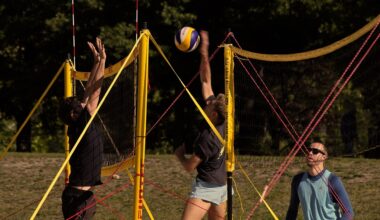Hydration Strategies for Long-Distance Endurance Events
Staying properly hydrated is crucial in long-distance endurance events such as marathons, triathlons, and ultra runs. Hydration not only helps maintain performance but also plays a vital role in the body’s overall safety. During extended physical activity, we lose fluids through sweat and breathe, making it essential to replace those fluids regularly. Athletes should devise a personalized hydration strategy based on several factors, including temperature, humidity, and individual sweat rate. To determine dehydration levels, pay attention to your body’s signals. Symptoms may include increased thirst, fatigue, or muscle cramps. Logically, frequent drinking is the best approach to avoid these issues. The widely recommended strategy includes consuming fluids at predetermined intervals. This can mean drinking every 20 minutes during events lasting over two hours, offering the best chances of success during races. Planning ensures that you replace lost fluids and helps you maintain optimal performance levels throughout the event. With diligent attention to hydration, athletes can avoid dehydration and its pitfalls, leading to a stronger overall experience. Each event may require adjustments, so tailor your approach based on your unique performance needs.
The Importance of Electrolytes
In addition to water, electrolytes play an essential role in hydration for long-distance endurance events. These minerals help regulate various bodily functions, including nerve signaling, muscle contractions, and hydration balance. Key electrolytes include sodium, potassium, calcium, and magnesium. Replenishing these minerals during extended exercise can enhance performance and prevent issues such as cramps and fatigue. Sports drinks often contain added electrolytes, making them a popular choice for athletes. Yet, you can also obtain electrolytes from whole foods like bananas, oranges, and nuts. It is essential to consume both fluids and electrolytes during endurance events to stay at peak performance. Different individuals have varying requirements for electrolytes based on factors like workout intensity, sweat rate, and training habits. To monitor your electrolyte levels, experiment with different strategies during training sessions. Assess how your body reacts to various hydration options, including electrolyte supplements or sports drinks. The goal is to develop the best regimen to address your unique needs. Focusing on both water and electrolytes can optimize performance, delaying fatigue and improving endurance throughout long-distance challenges.
Choosing the right type of hydration is critical for success during long-distance endurance events. While water is the most common choice, other options might be more effective based on the duration and intensity of the race. Sports beverages, for example, provide carbohydrates and electrolytes, which can enhance performance and prolong endurance. These drinks are particularly beneficial for events lasting over an hour, as they help maintain energy levels. Also, consider alternatives like electrolyte tablets or powders, which allow for customized electrolysis without excess sugar found in some drinks. Experimenting with various hydration methods during training can help you identify what works best for you. Another important factor in your hydration strategy is temperature; colder beverages can provide relief during hot weather, while warm options might be better during chilly conditions. In addition, always have a hydration plan in place before the event—knowing when and how much you are going to drink helps with consistent fluid intake. Finally, listen to your body; it will send signals when it needs hydration. This proactive approach allows you to achieve optimal performance, regardless of the endurance challenge ahead.
Finding the best hydration strategy involves trial and preparation. As race day approaches, it is essential to establish a routine that determines your fluid and electrolyte intake. Start by assessing your pre-race hydration habits. To avoid starting the event in a dehydrated state, ensure that you are drinking enough fluids leading up to race day. During training runs or long workouts, experiment with both hydration volume and timing. Keep track of how often you drink and adjust it according to your feedback. Consider temperature and humidity conditions when developing your strategy, as these factors will influence your hydration needs. Moreover, practicing your hydration strategy helps your body adapt. On race day, stick with what has worked for you in training to minimize surprises. Staying consistent with your approach—whether it’s the volume of fluids or timing—further enhances your performance. Furthermore, communicate your hydration needs to your support crew if you have one. This enables them to assist you effectively during the event. By having a well-structured plan, you can reduce the risk of dehydration and optimize performance throughout your endurance challenge.
Post-Race Hydration Recovery
Once you complete a long-distance endurance event, recovery becomes critical. Hydration plays a vital role in post-race recovery. Replenishing lost fluids helps restore electrolyte balance and assists your muscles in the repair process. After finishing, aim to drink water or a sports drink within thirty minutes to begin rehydrating as your body needs it most. In addition, incorporating a balance of carbohydrates, proteins, and fats into your post-race meal will further aid recovery. Nutrients work akin to hydration; when combined efficiently, they stimulate muscle growth and repair. Many athletes find that low-sugar coconut water or electrolyte drinks can effectively replenish what was lost during the event. In addition, aim to consume nutrient-dense foods that promote healing. This should include fruits, vegetables, lean proteins, and whole grains. Monitor your body throughout the recovery phase to ensure proper hydration levels and address excess fatigue or cramping efficiently. It is essential to extend your hydration recovery plan for up to 24 hours post-event. By doing so, distractions are reduced, allowing optimal recovery in preparation for future training or competitive events.
In conclusion, developing effective hydration strategies for long-distance endurance events is essential for athletes. Understanding the importance of fluid and electrolyte intake can significantly influence overall performance. Proper hydration not only enhances stamina but also promotes safety by preventing health issues related to dehydration. Establishing a routine that includes a mix of water, electrolyte-rich beverages, and whole foods serves to support athletes during training and competition. Remember to adjust your hydration plan according to weather conditions, race intensity, and your body’s signals. Finding the right balance will aid in maximizing endurance and performance levels, particularly during strenuous events. Experimenting with different methods throughout your training regime ensures that you are prepared for race day, equipped with a comprehensive hydration plan tailored for your individual needs. Keeping fluids accessible and maintaining consistent intake is vital. Additionally, monitor your hydration levels meticulously throughout the event. As you cross the finish line, recognize the significance of post-race hydration as part of your overall recovery strategy. By dedicating time to hydration preparation and planning, you are setting yourself up for success in future endurance challenges.
Final Tips for Hydration Success
As you embark on your journey towards mastering hydration strategies, consider these final tips to ensure your success during long-distance endurance events. First and foremost, practice makes perfect. Simulate race day scenarios during your training, allowing for greater familiarity with your hydration tactics. Furthermore, always listen to your body. Individual hydration needs can vary greatly based on numerous factors like age, fitness levels, and metabolic rates. Adjust your intake accordingly and use training sessions to gauge your personal hydration threshold. Stay organized and plan your hydration checkpoints before the event, making sure that you have adequate access to water and electrolyte sources. Also, include your support team in your hydration strategy if applicable; they can facilitate timely refills and offer encouragement along the way. Consider keeping a hydration log, documenting your fluid intake throughout training and post-race recovery; this record can be instrumental in identifying trends and improving future performance. Finally, stay motivated! Hydration can enhance overall enjoyment and success, supporting you in achieving your endurance goals.
By addressing hydration strategically, you can take control of your endurance performance and stay in peak condition. Continuously educating yourself on hydration methods and being mindful of your personal needs will increase your chances of achieving success. Each athlete’s experience is unique, but by sharing insights and strategies within the fitness community, we can all advance together. Start integrating these hydration concepts into your training and experience the powerful impact they can have on your endurance journey. Remember, hydration is not just a task; it is fundamentally linked to your overall health and performance. So focus on achieving hydration mastery, and your body will reward you throughout your long-distance challenges!


